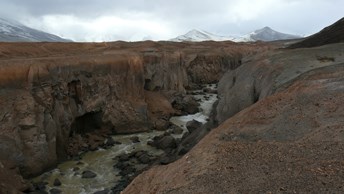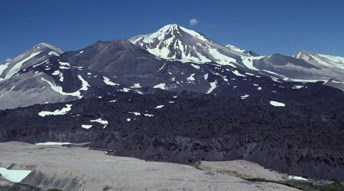
NPS/M. Fitz Katmai National Park and Preserve is one of the world's most active volcanic areas. Within Katmai’s boundaries lies at least 14 active volcanoes. The Alaska Peninsula and the Aleutian Islands have about 80 major volcanic centers that consist of one or more volcanoes. These volcanoes are pipelines into the fiery cauldron that underlies Alaska's southern coast. Why So Many Volcanoes in Katmai and Alaska? 
USGS Image The theory of plate tectonics attributes this phenomenon to the collision of the plates that makes up the Earth's crust. As the USGS states, “In a nutshell, this theory states that the Earth’s outermost layer is fragmented into a dozen or more large and small solid slabs, called lithospheric plates or tectonic plates, that are moving relative to one another as they ride atop hotter, more mobile mantle material (called the asthenosphere). The average rates of motion of these restless plates—in the past as well as the present—range from less than 1 to more than 15 centimeters per year. With some notable exceptions, nearly all the world’s earthquake and volcanic activity occur along or near boundaries between plates.” 
USGS Diagram More locally, the denser, oceanic Pacific Plate is subducting under the lighter, continental North American Plate around 2.5 in (6 cm) per year. The rocks of the Pacific Plate contain a significant amount of water. As this plate is driven under North America, the water contained within the rock is released and rises toward the earth’s surface. As it does so, it lowers the surrounding rocks’ melting point. This process is similar to adding a chemical flux to solder. As the rock melts, it rises toward the earth’s surface as magma. Some of this magma will eventually erupt at one of Katmai or Alaska’s many volcanoes. 
NPS/R. Wood 
NPS/M. Fitz Since their beginnings a few hundred thousand years ago, the Katmai volcanoes have been mostly quiet, punctuated only sporadically by short periods of eruptive activity. Fumaroles, steaming craters, earthquakes, and the occasional eruption all indicate that molten rock is still present under the crest of the Aleutian Range. Three volcanic eruptions occurred in here recently: Novarupta-Katmai (1912), Mount Trident (1953-1974), and Fourpeaked Volcano (2006). The Plinian style eruption at Novarupta on June 6-8, 1912 was the world’s largest volcanic eruption of the 20th century and one of the five largest in recorded history. No volcanic eruption since Tambora in 1815 has surpassed it. This was an exceptional event and while similar eruptions have occurred in Alaska during the past 10,000 years, this eruption is not typical for the region. 
NPS In contrast, Mount Trident’s and Fourpeaked Volcano’s recent eruptive activities are considered to be more typical for Katmai and Alaska’s volcanoes. At Mount Trident, four blocky lava flows poured from a vent on the southern slopes of the volcano in 1953, 1957, 1958, and during the winter of 1959-60. Intermittent explosions continued at Trident until 1974. On September 17, 2006, small phreatic eruptions occurred near the summit of Fourpeaked Volcano and volcanic unrest continued from September 30 through October 24. Until this time, evidence for eruptions at Fourpeaked within the past 10,000 years was uncertain. What Might the Future Hold? 
NPS/M. Fitz |
|
|
Last updated: June 22, 2020
